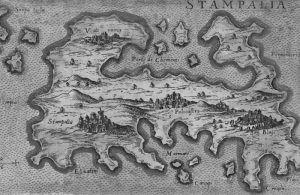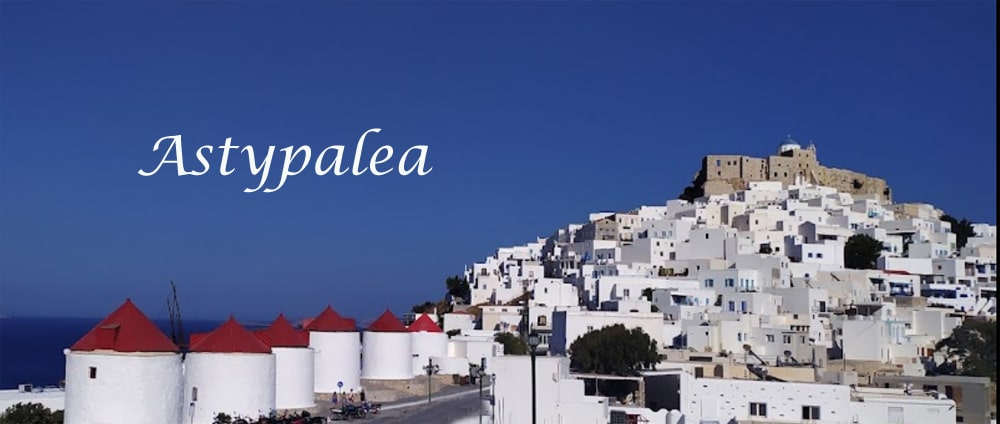A brief history of Astypalea

From an inscription of the 4th century BC. found in the Asklepiion of Epidaurus, it seems that the first Astypalites were of Argolic origin, as was their dialect.
As for the name of Astypalea, many believe that it comes from “Astypalaion”, because, before the Greeks inhabited it, the Phoenicians had a trading post there. It is also said that in Kos there was an old state called Astypalea, which was destroyed by earthquakes and that its people came and inhabited this island, giving it the name of their old homeland.
Astypalea still has a rectory, stoa and sanctuaries that worshiped Zeus, Asclepius, Athena, Poseidon, Artemis and Dionysus. Apart from them, the Astypalites had deified both their champions, Onesikritos and the great Cleomedes. The latter had fallen in the estimation of his fellow men because he was so enraged at winning the laurel of Olympia in the 71st Olympiad that, in a terrible boxing match with Epidaurus Iccus, he killed his opponent.
Ancient times
The heyday of ancient Astypalea is also evidenced by the coins of the 3rd, 2nd and 1st centuries BC, with the heads of Perseus, Dionysus, Asclepius and Athena, found there. The strict operation of its laws was equal to the prosperous Rhodian era. For a while the island was subject to the hegemony of the Athenians, as it is mentioned in the terminological lists.
From all seafarers, Astypalea was considered a valuable commercial ladder, connecting the West with the East, but more so between Cyprus, Rhodes, Kos and the rest of Greece.
Roman Period
In Roman times, because the island has natural harbors and deep bays, it was used as a base for the pursuit of corsairs. The Romans had also concluded an alliance with the Astypalites of that time, and the document of the alliance, written in duplicate, was deposited, one in the temple of Zeus, inside the Capitol of Rome, and the other in the temple of Athena and Asclepius in Astypalea. With this official contract renewed in 105 BC, Astypalea received from the Romans the nickname “civitas foederata”.
Byzantine period
After the Franks conquered Byzantium in the 4th Crusade of 1204 and divided the Aegean islands, the duke of Naxos Markos Sanoudos enthroned the Venetian aristocrat Ioannis Quirini in Astypalea in 1207, who was also the first owner of the castle. For years Astypalea remained under Frankish occupation, until in 1269 it was conquered by the Byzantines. The population of the island has greatly decreased for this reason its ruler, who was also master of Tinos and Mykonos, thought of transferring settlers from these two islands to inhabit Astypalea, which had been uninhabited for 72 years.
Ottoman rule and the Greek revolution
Later the Turks granted, according to their sacred law, many privileges to the islands which immediately declared their subjection to them. They left them free self-government and their inhabitants only paid a small annual tax..
The small islands lived peacefully for years with the Turks, maintaining their Greekness and their language, which was the official language between the community authorities of the place, the authorities of Rhodes and the Gate. Trade and sponge-making were in great prosperity as well as Greek education. But with the Greek uprising in the revolution of 1821, everything stopped for the islanders in sea and land, in order to commit themselves into the revoloution.
Liberation and unification with Greece
In 1828, after Astypalea was briefly ceded to Greece with the Southern Cyclades, it was then given back to Turkey, as was done with the other southern Sporades, according to the London protocol in 1830. The Italian occupation in 1912 with its pressures and restrictions, as well as the poverty of most of the islands, again forced the Astypalites into a new sojourn. So little by little these places lost their vitality and their first prosperity without their inhabitants losing their vitality, trying to work the land and plow the surrounding seas, so that their islands do not fall into wither. In 1948, together with the rest of the Dodecanese, Astypalea was united with Greece.
